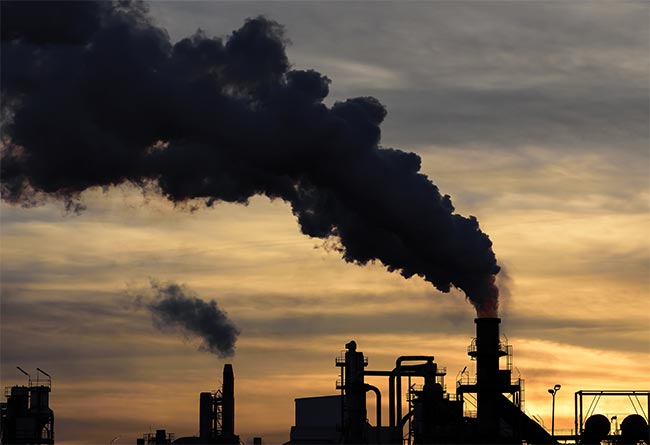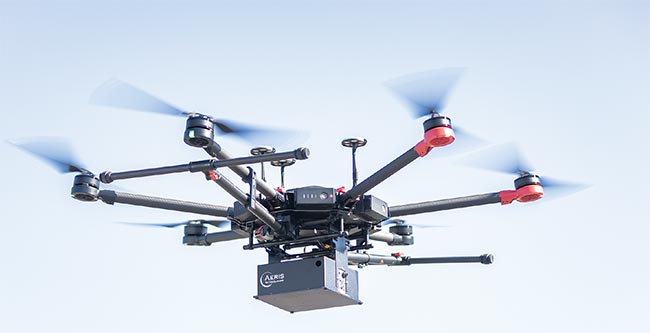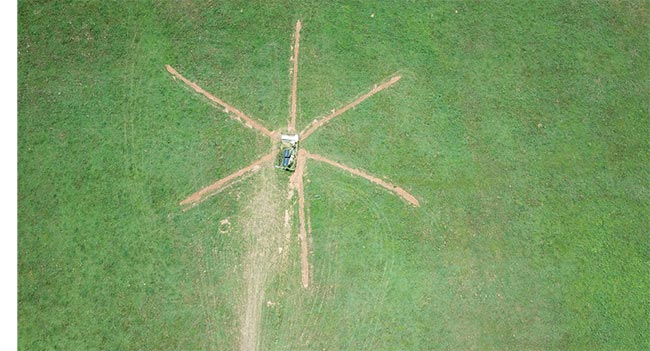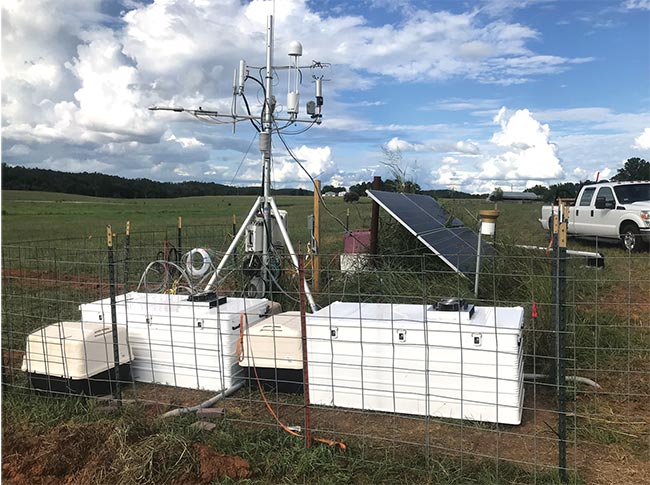Quantum cascade lasers offer unprecedented sensitivity and stability, making them a top choice for MIR gas sensing.
MICHAEL EISENSTEIN, CONTRIBUTING EDITOR
Far above an oil pipeline, a drone bobs and weaves. The drone, dispatched by Denver, Colorado-based Project
Canary, is collecting high-resolution imaging data of the site, while also scanning for any indications that the pipeline is leaking methane.
Methane is a potent greenhouse gas, and Project Canary cofounder and co-CEO Will Foiles saw a valuable opportunity to act against climate change by giving oil and gas facilities the ability to quickly detect and prevent its release into the atmosphere.

A cloud of pollution emanates from an oil and gas facility. Giving such facilities the ability to quickly detect and prevent the release of methane gases into the atmosphere can help in the fight against climate change. Courtesy of iStock.com/rui noronha.
“It has a short atmospheric residence,” he said, drawing a contrast to carbon dioxide, which can linger long after emissions subside. “So, if we really reduce our methane emissions today, the absolute levels of methane can go down.”
This also requires a quick and sensitive sensor platform, and Foiles is making use of compact mid-infrared (MIR) gas analysis systems developed by Aeris Technologies, a subsidiary of Project Canary. This region of the spectrum provides a critical window into which gases are present in a sample, and Aeris is one of a growing number of companies turning to a new generation of lasers, including quantum cascade lasers (QCLs) and interband
cascade lasers (ICLs), for probing the MIR region with astonishing sensitivity in a variety of domains.
“In terms of the global market, more so in Europe and China, it’s very popular for vehicle emissions or process emissions,” said Gary Spingarn, a product manager at Hamamatsu, which manufactures QCLs. “Where it has really taken off in the U.S. is very high-sensitivity gas analysis for contaminants in semiconductor manufacturing, but also looking at the bulk gases that are supplied to the semiconductor industry.” In this context, the ability to detect vanishingly small traces of
contaminants — at the parts-per-trillion scale — can be essential.
Even as QCL-based gas sensors continue to advance, the technology is held back by the high cost of these laser sources. But ongoing innovation in this field is revealing use cases for which this technology is essentially indispensable.
“Nothing else can do the things that people are doing with our laser — there’s no alternative,” said Anish Goyal, vice president of technology at Block Engineering, in regard to his company’s widely tunable QCLs for multi-gas analysis.
Cutting through the noise
Even clean air is crowded with a diverse array of molecules, and cleanly picking out the signal from a compound of interest is a thorny challenge. Spectroscopic analysis at long wavelengths offers a powerful mechanism for cutting through the noise.

A drone equipped with a compact MIR gas analysis system flies overhead. Aeris incorporated a quantum cascade laser (QCL) into the system to probe the MIR region for the presence of analytes in the atmosphere. Courtesy of Aeris.
“It’s very sensitive because molecules have unique spectra and very high absorption strength in the longwave and mid-infrared,” Goyal said. “It’s very sensitive and very specific.” This makes it easy to obtain a crisp signal from a desired analyte without background interferents, such as water. Indeed, Spingarn said that the most important compounds in the domains of environmental health and emissions monitoring produce distinctive absorbance signatures in the 3- to 12-µm wavelength range of the MIR spectrum.
This is not a new idea.
“We started infrared gas analysis about 60 years ago,” said Kyoji Shibuya, a
researcher with the advanced R&D team at Horiba. Block Engineering also pioneered the commercialization of IR gas analysis in the late 1960s. These instruments used methods such as nondispersive IR (NDIR) and Fourier transform IR (FTIR) spectroscopy, which employ lamp sources that emit across broad swathes of the IR spectrum. Such approaches are still in widespread use but involve compromises. FTIR is slow and expensive, whereas NDIR systems are more affordable but limited in terms of the peak sensitivity and specificity that they can deliver, Spingarn said. “[NDIR systems will] be good for lower accuracy or performance applications, but not for analytical purposes or anything having
to do with stronger governmental regulations, for example,” he said.
Laser sources churn out far greater quantities of tightly focused, wavelength-specific photons, conferring an edge in terms of sensitivity. Early forays into laser-based gas sensing employed lead-salt lasers, which can cover much of the MIR spectrum but also require cryogenic cooling to maintain stable performance. “You have to fill the tank with liquid nitrogen every morning when you start your experiments,” said Aeris CEO Jerome Thiebaud. “So you know it’s going to work in the lab, but not exactly compatible with flying the device on a drone.”
QCLs have been a game changer. The lasers are constructed from many layers of semiconductor materials that form electron-trapping quantum wells. By adjusting the configuration of these wells, laser manufacturers can precisely tune photon emission, achieving unprecedented control over the wavelength of the resulting beam. “If I want a laser operating at 5.26 µm because I know that there is a very good absorption line for nitric oxide, I can ask the industry and they
are able to realize such a laser,” said
Vincenzo Spagnolo, a physicist at the Polytechnic University of Bari in Italy, who is collaborating with QCL manufacturer Thorlabs to develop MIR gas sensing systems. QCLs are also easier to
operate than their predecessors and
considerably more stable, with many
contemporary sources capable of operating at ambient temperatures without external cooling.

The mapping of nitrous oxide isotopic signatures in soil using subsurface gas probes buried up to 30 m from a central Aerodyne TILDAS analyzer. The isotopic signatures encode information about the nitrogen cycling pathways that are active near the probe. Courtesy of Aerodyne.

This chart shows the MIR spectrum and the different analytes that pop up at various absorbance wavelengths. Courtesy of Hamamatsu.
Additional iterations on this beam design are further extending the breadth of applications. For example, French laser company mirSense has developed antimonide lasers that push even farther into the MIR than do conventional QCLs, achieving wavelengths of up to 17 µm. Spagnolo has worked with these sources, and he said that they are especially useful for detecting complex toxic gas molecules, such as benzene or toluene, which are more difficult to measure at shorter wavelengths.
Companies including nanoplus and Alpes Lasers also offer ICLs, which operate on a principle similar to QCLs but cost considerably less. Spingarn estimated that for a high-volume application, an ICL could cost around $1000 versus $8000 to $10,000 for a QCL. However, there are trade-offs. Current-generation ICLs cover a narrower slice of the MIR region, in the range of 3 to 6 µm, and cannot match the power output of QCLs. This range still enables sensitive detection of a number of important gas analytes, and companies such as Aeris and Aerodyne Research make use of ICLs in their gas sensors. “We mix and match [ICLs and QCLs] and we go after hard gases that others haven’t done,” said Barry McManus, principal scientist at Aerodyne.
Focused on the right applications
Manufacturers have pursued a range of different approaches to QCL-based detection that can deliver distinct advantages in different gas analysis applications. Many sensors on the market are based on an iteration of tunable diode laser absorbance spectroscopy (TDLAS), in which an air sample is illuminated with a laser tuned to a MIR wavelength matching the absorbance peak of a gas of interest. A sensitive detector subsequently records the absorption spectrum collected from the sample, and these readings are used to calculate the concentration of the target analyte.
Different groups have put their own spins on this method. For example, Horiba’s IR laser absorbance modulation
(IRLAM) systems are coupled to a proprietary algorithm that can quickly discriminate spectral features of interest from background interference and
noise. “As a result, we can dramatically reduce the calculation time,” said Shoto Hamauchi, a research scientist at Horiba. This in turn enables it to achieve a
continuous, real-time readout of gas measurements.

Aerodyne TILDAS instruments in their environmental enclosures performing double duty: One is dedicated to mapping subsurface nitrous oxide isotopic signatures, while the other is dedicated to measuring atmospheric nitrous oxide at a very high frequency (10× per s) to determine trace gas fluxes emanating from the surrounding soil. Courtesy of Aerodyne.
Other companies, such as mirSense, are pursuing photoacoustic spectroscopy, which uses ultrasensitive microphones to detect sound waves generated when target gas molecules are illuminated at a particular wavelength. Spagnolo’s team has been working with a distinctive version of this approach, first devised by Frank Tittel at Rice University, known as quartz-enhanced photoacoustic spectroscopy (QEPAS). Rather than a microphone, QEPAS uses a tiny quartz tuning fork to detect vibrations produced by gas mole-
cules excited between the fork’s prongs; these then produce a piezoelectric current that can be measured and interpreted. Thorlabs is selling QEPAS systems based on Spagnolo’s work. He has also founded a startup called PolySenSe Innovations to support additional gas sensor development in this space.
An optimized QCL sensor can achieve remarkable sensitivity. “It’s very molecule-dependent, but parts-per-billion is typically easy,” said Tara Yacovitch, a principal scientist at Aerodyne, which has achieved parts-per-trillion sensitivity for several gases. She said that such performance has proved to be valuable for the detection of rare isotopes in areas such as geology and soil science research.
Many applications in the semiconductor industry also demand such analytical precision. But in other cases, such as gas and oil facility monitoring, extreme sensitivity is less important. “For them, it’s not about a fraction of a part-per-billion,” said Thiebaud. “It’s about measuring those emissions with very high fidelity.” But even parts-per-million sensitivity can be an impressive achievement in some real-world conditions, such as in the context of measuring specific molecules in pollutant-laden vehicular exhaust. Shibuya said that Horiba’s IRLAM technology excels at achieving robust parts-per-million sensitivity in such applications, and their systems are being positioned to aid compliance with strict emissions standards such as the European Union’s Euro 7 guidelines.

A custom quartz tuning fork. Courtesy of Vincenzo Spagnolo.
Sensitivity is a product of many factors, including the power and coherence of the laser. But a long beam path is also important to maximize the opportunities for the beam to interact with scarce molecules in a sample. Many systems use gas cells, which internally reflect the QCL many times to achieve an extremely long beam in a compact footprint. For example, according to Thiebaud, the gas cells in Aeris’ sensors generate a 13-m beam path within a volume of just 60 cubed cm. On the other hand, Block Engineering’s LaserWarn system, which is designed to identify chemical weapons and other airborne threats in public spaces, is an open-path system that projects the beam directly into airport terminals and other spaces, with reflectors to return the signal to the detector. “We can detect gases in the parts-per-billion concentration range with a sufficiently long path length of the cloud,” Goyal said.
A compact form factor can also be valuable, for example, in sensors designed for hand-held or drone-borne applications.
Spagnolo touts this as a key asset for QEPAS systems, which
do not require a long beam path to achieve parts-per-trillion
sensitivity and can potentially be shrunk down to an ultraportable box measuring ~8 to 10 cm per side.
Finally, there is the matter of multianalyte detection. Most gas analysis systems use single-mode distributed feedback (DFB) QCLs, which are tuned to one wavelength and can enable the detection of one to three target gas molecules per beam. Many manufacturers, including Aeris, Horiba, Aerodyne, and Emerson, offer systems that can accommodate multiple laser sources, thereby multiplying the number of analytes that can be documented at once. In a particular case, Spagnolo has begun working with a new generation of ICL sources under development by nanoplus, in which three lasers are housed on a single mounting system and subsequently beam-combined. This enables multi-beam detection without adding bulk to the sensor.
There are other alternatives, such as the broadly tunable QCLs manufactured by Block Engineering, and which the company has implemented in its LaserWarn platform. Unlike DFB lasers, which produce a continuous single-wavelength beam, Block Engineering produces rapidly pulsed beams that sweep across hundreds of wavelengths that span the MIR spectrum. “We can rapidly measure the transmission spectrum over a wide wavelength range, and then we can deconvolve that spectrum to isolate the individual contributions from the constituent gases,” Goyal said. Such capabilities are especially critical in the context of providing broad protection against airborne threats that can assume a myriad of forms, and the company claims that its system can effectively report on virtually any chemical weapon or toxic industrial gas.
Sensing new opportunities
Despite these advancements, the road ahead for QCL-based gas analysis remains unclear. According to Spingarn, FTIR remains firmly ensconced as a cost-effective and battle-tested technology for many applications. “The competition is brutal,” Spingarn said. But the extreme sensitivity, precision, and rapid analysis enabled by QCLs nevertheless makes them highly appealing. And for some use cases, there is simply no substitute available on the market.
Today, these beam sources remain labor-intensive and costly to manufacture.
Even veteran laser manufacturers must grapple with many challenges in meeting the needs of QCL customers, Spingarn said. “You’re wrestling with a laundry list of specifications, like the wavelength,
the output power, the I-V curve, the operating temperature range, power consumption — these are all moving parts,” he said. If specific sensing applications emerge that create strong demand, the emergence of an economy of scale could bring prices down dramatically. Spingarn cites the parallel of VCSELs, which have flourished as a component for vehicular sensors and telecommunications.
Nevertheless, the technology’s proponents are optimistic about the future for QCL-based sensing and see opportunities
for a “killer application” to emerge. For
example, QCL-based sensors that are tuned to recognize specific volatile compounds in breath could give clinicians a jump-start on detecting signatures of cancer or infectious diseases. Shibuya mentioned the emerging market for sustainable alternative fuels, which would require robust quality control to minimize impurities. Finally, there is the potential to democratize emissions monitoring by shrinking the size and cost of pollutant sensors down to a scale in which every community, or even every building, could be outfitted with the means to track
compounds that endanger human health. “In every HVAC system of high-rise buildings, you could know the amount of CO2, CO, nitrous oxide, and formaldehyde,” Thibeaud said. “That’s going to
really raise the bar in terms of our expectations about what is in the air we breathe.”